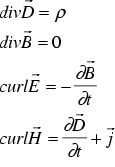 (
(  )
)
Until the 19th century electric and magnetic effects were seen as two independent physical occurences. In 1820 Oersted proved, that electric currents can influence the needle of a compass. Ampère and Faraday laid the foundation for the unified theory of electrodynamics, which was elaborated by James Clerk Maxwell (1831-1879).
His famous equations are the starting point for our investigations:
 (
(  )
)
In order to solve these equations for our purpose, we have to make several assumptions. First, we neglect any displacement currents  , which are typically relevant only at radio frequencies (in the MHz regime), and set
, which are typically relevant only at radio frequencies (in the MHz regime), and set  . In the quasistatic approximation we omit the the term
. In the quasistatic approximation we omit the the term
 (
(  )
)
Secondly, we assume, that there are no free charges (. The simplified Maxwell equations are given by
 (
(  )
)
Then, we require the field intensity  and the flux intensity
and the flux intensity  to obey the constitutive relationship
to obey the constitutive relationship
 . (
. (  )
)
If the material is nonlinear (e.g. ferromagnetic), the permeability ( is a function of B.
 (
(  )
)
However, we will consider only linear materials in this case in this project.
The relationship between the electric field intensity  and the current density
and the current density  is given by
is given by
 . (
. (  )
)
Now we introduce a magnetic vector potential  , and define it as
, and define it as
 (
(  )
)
which guarantees the validity of Maxwell's second equation. Then we can rewrite the fourth equation and obtain
 (
(  )
)
With the Coulomb gauge condition
 (
(  )
)
and the well known operator relation
 (
(  )
)
we find
 . (
. (  )
)
Inserting (7) in the third Maxwell equation yields
 . (
. (  )
)
In the case of 2D problems, we can integrate this equation and get
 (
(  )
)
and together with constitutive relationship between the electric field intensity  and the current density
and the current density  we obtain
we obtain
 (
(  )
)
Finally we insert this in (11) to eliminate  and arrive at
and arrive at
 , (
, (  )
)
where  represents the applied current sources.
represents the applied current sources.
Finally, we restrict ourselves to time harmonic problems, in which all fields oscillate harmonically at one fixed frequency. Thus, we can use a phasor transformation and rewrite the magnetic vector potential as
 (
(  )
)
in which  is the complex amplitude. By substituting this ansatz in (15) we can eliminate the time derivative and finally arrive at
is the complex amplitude. By substituting this ansatz in (15) we can eliminate the time derivative and finally arrive at
 . (
. (  )
)
![]()
![]()
![]()
![]()
Next: The finite element method
Up: Calculation of eddy currents
Previous: Calculation of eddy currents
Contents